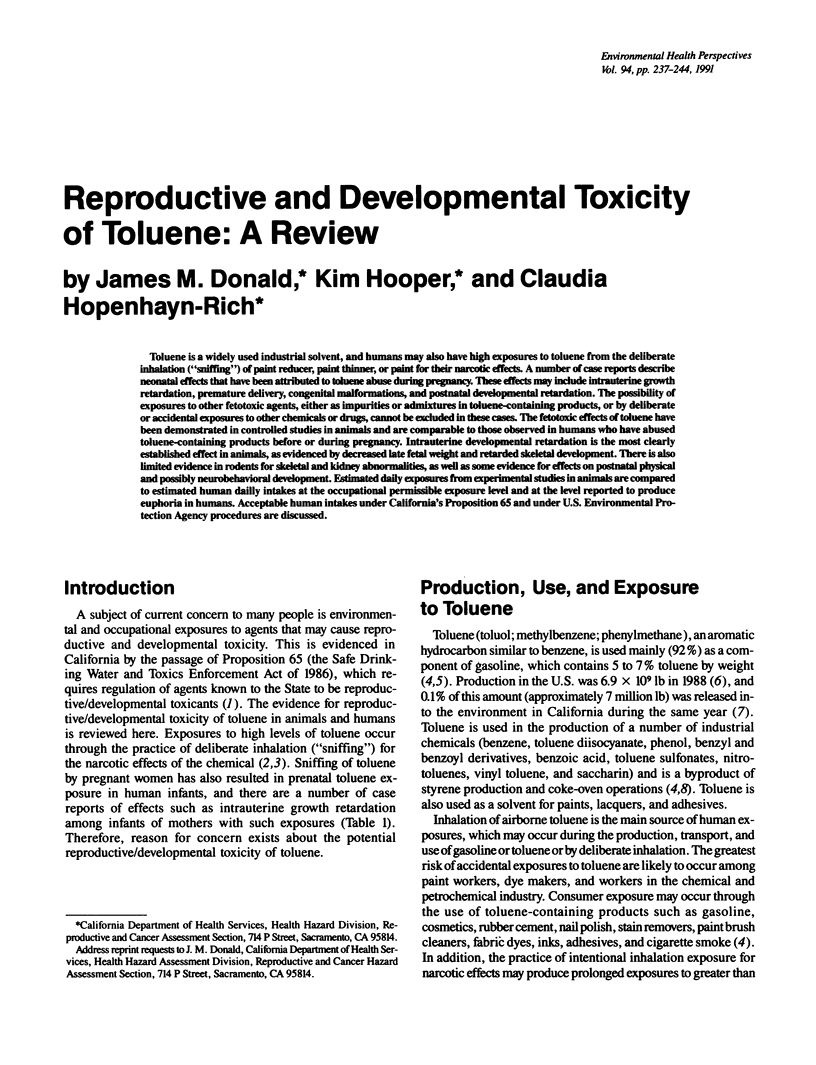Abstract
Toluene is a widely used industrial solvent, and humans may also have high exposures to toluene from the deliberate inhalation ("sniffing") of paint reducer, paint thinner, or paint for their narcotic effects. A number of case reports describe neonatal effects that have been attributed to toluene abuse during pregnancy. These effects may include intrauterine growth retardation, premature delivery, congenital malformations, and postnatal developmental retardation. The possibility of exposures to other fetotoxic agents, either as impurities or admixtures in toluene-containing products, or by deliberate or accidental exposures to other chemicals or drugs, cannot be excluded in these cases. The fetotoxic effects of toluene have been demonstrated in controlled studies in animals and are comparable to those observed in humans who have abused toluene-containing products before or during pregnancy. Intrauterine developmental retardation is the most clearly established effect in animals, as evidenced by decreased late fetal weight and retarded skeletal development. There is also limited evidence in rodents for skeletal and kidney abnormalities, as well as some evidence for effects on postnatal physical and possibly neurobehavioral development. Estimated daily exposures from experimental studies in animals are compared to estimated human daily intakes at the occupational permissible exposure level and at the level reported to produce euphoria in humans. Acceptable human intakes under California's Proposition 65 and under U.S. Environmental Protection Agency procedures are discussed.
Full text
PDF







Selected References
These references are in PubMed. This may not be the complete list of references from this article.
- Benignus V. A. Health effects of toluene: a review. Neurotoxicology. 1981 Nov;2(3):567–588. [PubMed] [Google Scholar]
- Courtney K. D., Andrews J. E., Springer J., Ménache M., Williams T., Dalley L., Graham J. A. A perinatal study of toluene in CD-1 mice. Fundam Appl Toxicol. 1986 Jan;6(1):145–154. doi: 10.1016/0272-0590(86)90270-8. [DOI] [PubMed] [Google Scholar]
- Ghantous H., Danielsson B. R. Placental transfer and distribution of toluene, xylene and benzene, and their metabolites during gestation in mice. Biol Res Pregnancy Perinatol. 1986;7(3):98–105. [PubMed] [Google Scholar]
- Goodwin T. M. Toluene abuse and renal tubular acidosis in pregnancy. Obstet Gynecol. 1988 May;71(5):715–718. [PubMed] [Google Scholar]
- Hersh J. H., Podruch P. E., Rogers G., Weisskopf B. Toluene embryopathy. J Pediatr. 1985 Jun;106(6):922–927. doi: 10.1016/s0022-3476(85)80238-9. [DOI] [PubMed] [Google Scholar]
- Hersh J. H. Toluene embryopathy: two new cases. J Med Genet. 1989 May;26(5):333–337. doi: 10.1136/jmg.26.5.333. [DOI] [PMC free article] [PubMed] [Google Scholar]
- Hudák A., Ungváry G. Embryotoxic effects of benzene and its methyl derivatives: toluene, xylene. Toxicology. 1978 Sep;11(1):55–63. doi: 10.1016/s0300-483x(78)90439-0. [DOI] [PubMed] [Google Scholar]
- Kizer K. W., Warriner T. E., Book S. A. Sound science in the implementation of public policy. A case report on California's Proposition 65. JAMA. 1988 Aug 19;260(7):951–955. [PubMed] [Google Scholar]
- Kostas J., Hotchin J. Behavioral effects of low-level perinatal exposure to toluene in mice. Neurobehav Toxicol Teratol. 1981 Winter;3(4):467–469. [PubMed] [Google Scholar]
- Low L. K., Meeks J. R., Mackerer C. R. Health effects of the alkylbenzenes. I. Toluene. Toxicol Ind Health. 1988 Mar;4(1):49–75. doi: 10.1177/074823378800400105. [DOI] [PubMed] [Google Scholar]
- McDonald J. C., Lavoie J., Côté R., McDonald A. D. Chemical exposures at work in early pregnancy and congenital defect: a case-referent study. Br J Ind Med. 1987 Aug;44(8):527–533. doi: 10.1136/oem.44.8.527. [DOI] [PMC free article] [PubMed] [Google Scholar]
- Shigeta S., Aikawa H., Misawa T., Yoshida T., Momotani H., Suzuki K. Learning impairment in rats following low-level toluene exposure during brain development--a comparative study of high avoidance rats and Wistar rats. Ind Health. 1986;24(4):203–211. doi: 10.2486/indhealth.24.203. [DOI] [PubMed] [Google Scholar]
- Streicher H. Z., Gabow P. A., Moss A. H., Kono D., Kaehny W. D. Syndromes of toluene sniffing in adults. Ann Intern Med. 1981 Jun;94(6):758–762. doi: 10.7326/0003-4819-94-6-758. [DOI] [PubMed] [Google Scholar]
- Suzuki T., Kashimura S., Umetsu K. Thinner abuse and aspermia. Med Sci Law. 1983 Jul;23(3):199–202. doi: 10.1177/002580248302300308. [DOI] [PubMed] [Google Scholar]
- Tátrai E., Rodics K., Ungváry G. Embryotoxic effects of simultaneously applied exposure of benzene and toluene. Folia Morphol (Praha) 1980;28(3):286–289. [PubMed] [Google Scholar]
- Ungváry G., Tátrai E. On the embryotoxic effects of benzene and its alkyl derivatives in mice, rats and rabbits. Arch Toxicol Suppl. 1985;8:425–430. doi: 10.1007/978-3-642-69928-3_95. [DOI] [PubMed] [Google Scholar]


